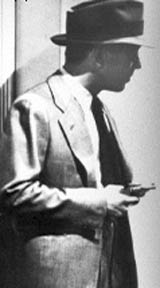
|
The Snub
Nose Classic companion of detectives, inspectors and other good guys. 
Movie pictures found on the web |
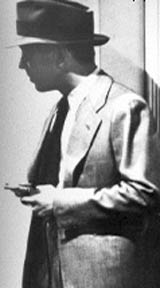
|
| The Myth |
The Facts |
A 45 Sub Nose? |
Personal
Examples |
The Myth
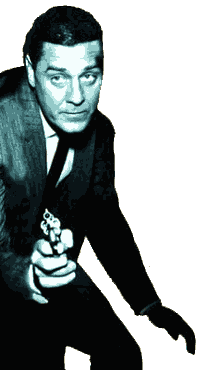 In the eighteen hundreds, Colt took it's
legendary Peacemaker revolver, and put a very short barrel on it, calling
the result the Sheriff's Model. The short barrel was designed to speed
up the draw, and to make the gun a bit easier to carry, or to conceal.
As is still the case today, shortening the barrel compromised the performance
of the gun a bit, and made it a bit more difficult to reload (the empties
had to be punched out of the chambers with a pencil), but the guns were
very small. There had been earlier short barreled pistols, even going
back to the days of the single shot black powder guns. There had been
earlier short barreled revolvers too. The famous pepperbox guns of the
very early eighteen hundreds, for example. Still, most gun enthusiasts
consider the Sheriff's model to be the precursor to that most classic of
all detective arms, the snub nose revolver.
In the eighteen hundreds, Colt took it's
legendary Peacemaker revolver, and put a very short barrel on it, calling
the result the Sheriff's Model. The short barrel was designed to speed
up the draw, and to make the gun a bit easier to carry, or to conceal.
As is still the case today, shortening the barrel compromised the performance
of the gun a bit, and made it a bit more difficult to reload (the empties
had to be punched out of the chambers with a pencil), but the guns were
very small. There had been earlier short barreled pistols, even going
back to the days of the single shot black powder guns. There had been
earlier short barreled revolvers too. The famous pepperbox guns of the
very early eighteen hundreds, for example. Still, most gun enthusiasts
consider the Sheriff's model to be the precursor to that most classic of
all detective arms, the snub nose revolver.The classic snub nose was the stuff of dreams and adventure for several generations of young (and not so young) boys who watched their heroes so armed, defeat bad guys, protect
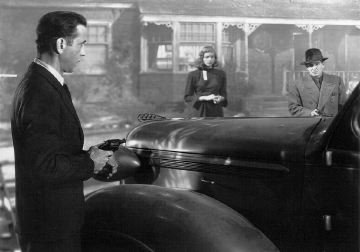 the innocent, and generally make themselves useful to society,
as well as indispensable, if not irresistible, to members of the opposite
sex. These guns, as we have come to think of them today, began
life as cut down versions of standard service revolvers. They carried
such names as The Banker's Model, The Chief's Model, The Bodyguard, and
The Detective Special.
the innocent, and generally make themselves useful to society,
as well as indispensable, if not irresistible, to members of the opposite
sex. These guns, as we have come to think of them today, began
life as cut down versions of standard service revolvers. They carried
such names as The Banker's Model, The Chief's Model, The Bodyguard, and
The Detective Special. William Powell, Humphrey Bogart, and Alan Ladd carried Snub nose revolvers, as hard boiled 30's and 40's private eyes. In the fifties, no television, movie, or radio detective would consider carrying anything else. Steve McQueen carried one as Bullitt, a sixties hard boiled detective, as did scores of television detectives throughout the sixties and seventies. A snub nose was used in the Godfather by Michael to assassinate rival gang members in an Italian restaurant. In real life, the snub nose was the favorite of detectives, plain clothes officers, and off duty policemen.
As a child growing up in the sixties, it seemed to me that there were really only two genuine pistols being carried in the world. Villains and heroes alike, either had a 38 snub nose, or a 45 automatic. Really, according to television and the movies, this was about all that there was. Rank and file police officers carried four inch service revolvers, bigger clumsier versions of the elegant little snub noses carried by their betters. Once and a while there might be a Luger, a P-38, or some other exotic, but these were the exceptions, made notable by their eccentricity. As an example, Sam Spade's Partner was killed by a Webley in the Maltese
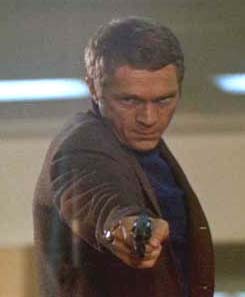 Falcon. So it was occasionally brought to our attention that
there were other guns in the world, but little merit was assigned
to them.
Falcon. So it was occasionally brought to our attention that
there were other guns in the world, but little merit was assigned
to them. The classic Snub nose, is a double action revolver with a two inch barrel, though some are a bit shorter, or a bit longer. The traditional caliber is the 38 Special, though they have been made in everything from 22 Long Rifle to .44 Special. The first guns were standard Service revolvers, like the S&W Model 10, with shorter barrels to make them easier to carry and conceal, just like the old Sheriff's Model. The guns quickly developed a following among certain people who needed to be discreetly armed. Politicians, detectives, those who carried large amounts of money in their work, all needed just a bit more security, but could hardly strap on a gun belt and go out in public. Police detectives were considered to be professionals, and wore jackets and ties
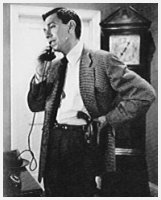 to work, rather than the uniform of a police officer. They
were gentlemen, after all, and worked with their intellect to solve
crimes. It would not do to have them overtly armed like common policemen
to work, rather than the uniform of a police officer. They
were gentlemen, after all, and worked with their intellect to solve
crimes. It would not do to have them overtly armed like common policemenThe FBI, begun as an investigative organization, rather than a law enforcement agency, was initially unarmed. When, after the loss of numerous agents, it was decided to arm investigators, they retained their suits, and their professional demeanor, but wore trusty 38 Special snub nose revolvers under them. Thus a certain air of sophistication and elitism began to hover around the little wheel guns. This was not lost on civilian buyers, or on the marketing departments of the gun manufacturers.
A snub nose was always just a little bit more desirable than the standard duty model of the same gun. Ironically, a snub nose model of a standard gun would often cost more than the same model with a longer four or a six inch barrel. Fewer snub nose variants were produced, and there could even be waiting lists or back orders for the little guns. Part of the mystique was probably caused by the purpose served by the venerable snub nose. These were not hunting or target guns. If you carried a snub nose, it was for self protection, and use in combat against other human beings. This fact, added a bit of
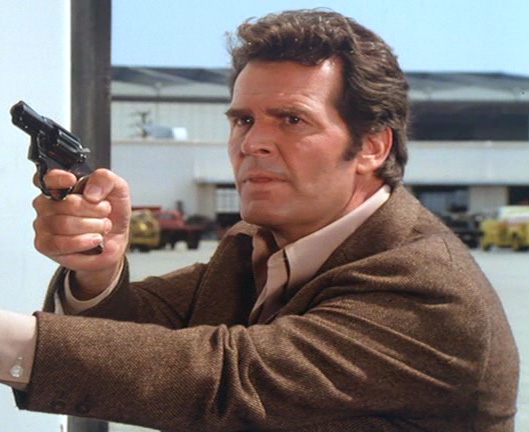 shadiness to the otherwise sterling reputation of the snub nose. If you
were not a detective, or
shadiness to the otherwise sterling reputation of the snub nose. If you
were not a detective, or 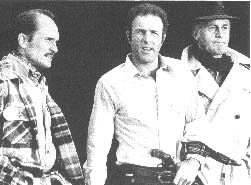 some other kind of investigator, why on Earth would you need
one? This slight hands off attitude made these guns that much more desirable.
So in civilian ownership too, the snub nose began to be the gun in the
night stand, or the pistol in the glove compartment. Occasionally, it
filled the role of the gun in the pocket or waistband. Since concealed
carry has been illegal in most places for a century (a situation which
has happily been rectified in most states over the last decade or so),
this simply added to it's image.
some other kind of investigator, why on Earth would you need
one? This slight hands off attitude made these guns that much more desirable.
So in civilian ownership too, the snub nose began to be the gun in the
night stand, or the pistol in the glove compartment. Occasionally, it
filled the role of the gun in the pocket or waistband. Since concealed
carry has been illegal in most places for a century (a situation which
has happily been rectified in most states over the last decade or so),
this simply added to it's image. Even as the semiautomatic pistol began to eclipse the revolver in police use, the snub nose continued to serve undercover. In part, this is because until very recently, no suitable automatic pistol was made which could be as easily concealed. The only small automatics made at the time were the "vest pocket" models. These were generally 22 or 25 automatics with terrible sights, poor accuracy, and little power. Though some were very well made, many were cheap and exhibited poor quality. This class of weapon would latter be given the nick name of Saturday Night Special, and efforts would be made to ban it's manufacture and sale. Interestingly, the snub nose would also be slandered by these same spin doctors, for the same reason.
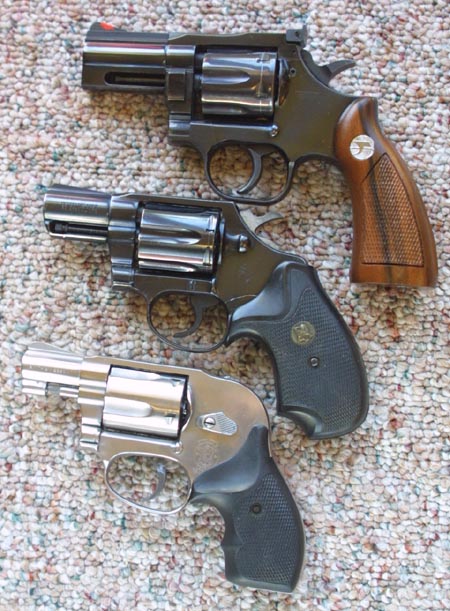 All myths aside, the venerable snub nose is a pretty demanding
weapon. The small size, full powered cartridge, short barrel and light
weight conspire to make the diminutive little beasts a real handful
to shoot. The short barrel decreases muzzle velocity, making the little
guns somewhat less effective than their longer barreled brethren.
The shorter sighting radius makes them more difficult to aim, and
increases the muzzle flash. Their lighter weight significantly
increases felt recoil. However, these pint sized revolvers do have
two very important things in their favor, which explains their popularity;
they are easy to conceal, and they look neat.
All myths aside, the venerable snub nose is a pretty demanding
weapon. The small size, full powered cartridge, short barrel and light
weight conspire to make the diminutive little beasts a real handful
to shoot. The short barrel decreases muzzle velocity, making the little
guns somewhat less effective than their longer barreled brethren.
The shorter sighting radius makes them more difficult to aim, and
increases the muzzle flash. Their lighter weight significantly
increases felt recoil. However, these pint sized revolvers do have
two very important things in their favor, which explains their popularity;
they are easy to conceal, and they look neat. From a practical point of view, the snub nose is the most powerful gun on the market, for it's size. This is particularly true, if you discard tradition, and get yourself a 357 model or one of the medium frame 44 models, instead of a classic 38. The 38 is somewhat superior to the 9 mm, and the 44 Special is just below the 45 automatic. Though the snub nose revolver lacks the firepower of these guns, being limited to six, or even five rounds, it fires a full powered cartridge in the smallest possible form factor. Shown in the photograph to the right, is my current collection of traditional snub nose revolvers. These are the small frame Body guard from S&W with the shrouded hammer, the medium frame Colt Detective Special, and the slightly larger Dan Wesson medium frame.
When considered in the context of it's intended role, the snub nose revolver is not as handicapped by it's lack of firepower, and it's other deficiencies, as might seem to be the case. Most defensive encounters with handguns take place at very close range, twenty feet or less. They also tend to happen quite quickly, in a matter of a few seconds. Few rounds are fired, and it is rare for the participants to have to reload their guns, which is just as well for the snub nose revolver owner, since the shortened ejector rod does not have a long enough stroke to completely clear the empties from the chambers. In such situations, it is generally the first round or two that decide the matter. With it's lack of safeties to take off, hammers to cock, or slides to pull back, the revolver is often the quickest gun to bring into action. More important still, the revolver is able to accept and reliably feed any style of ammunition. A 38 snub nose can be loaded with +P rounds using one of the new frangible style bullets. Some of the more drastically shaped bullet styles do not always feed reliably in semi automatics. A revolver is a very simple, direct, and reliable device. Revolvers do not jam, fail to feed, or become useless after a misfire. Unless the shooter dedicates considerable time to training, and weapon familiarization, a revolver will always be faster to bring into action than a semi automatic. Even
Though their cylinders can be bulky, this problem is often overstated and revolvers can be made very small indeed. Interestingly, both the revolver, and the auto are thickest in the place the ammunition is kept. No semi auto firing a full powered cartridge can be made as short as a snub nose revolver. The small frame models, like the J frame Smith and Wesson, use five shot cylinders which make the cylinders on these little guns almost as thin as the frame of a medium framed automatic. Other than in the cylinder area, revolvers are very thin, when compared to automatics, and their curves can sometimes make concealment easier than the angular dimensions, and boxy shapes of many automatics.
Short barreled guns do present special problems, whether revolver or automatic. The most apparent is the difficulty in accurately aiming a gun with such a small sight radius. Most shooters have a hard time getting better than 3 inch groups with a snub nose, and five inch groups are probably more common. Another impairment is the almost universal installation of fixed sights on snub nose revolvers. Though there are some
Another problem with all small guns, is the difficulty most shooters have in controlling them. A small gun kicks harder than a larger gun, because there is less weight in the frame to provide inertia against the force of the cartridge. This can make the shooter flinch, further degrading accuracy. Related to this is a significant increase in muzzle flash. Muzzle flash is caused by powder continuing to burn after the bullet has left the barrel. Not only is it distracting to the shooter, but it also indicates inefficiency, because powder which burns after the bullet has exited the firearm does not add to the energy of the round. There are two ways to reduce or eliminate muzzle flash. The first is to go with a longer barrel, which gives the powder time to burn completely before the bullet exits the muzzle. The second is to go with a faster burning powder, such as Bullseye. The use of fast burning powders is really the only option for the snub nose. The problem is magnified by the use of magnum rounds in snub nose revolvers. Magnums depend upon slow burning powders and long barrels to get their high velocities. A two inch barrel which somewhat reduces the power of a 38 Special, will drastically reduce the power of a 357 Magnum. At the same time, the 357 will produce greatly more muzzle flash and recoil, and be very difficult to control. Though the magnum round, even out of a short barrel, will have more energy than the 38, I do not consider this slight increase to be worth the extra difficulty in shooting such a gun. Because 357, and 38 snub nose guns are generally built on the same frames, the use of a magnum round also subjects the gun to considerably more wear.
Shown in the photos above are some side by side comparisons of a S&W J frame snub nose, in this case a model 649, and one of the new series of very compact full size automatics, as described below. Note how much more compact and concealable the snub nose is, despite it's bulky cylinder.
In the fifties, Colt shortened the venerable 1911 Government Model by one inch, and created the Colt Commander. At the same time, S&W came up with the Model 39, in 9 mm, which was also somewhat shorter than the full sized Colt model. Both guns were sized the same for an upcoming set of handgun trials. The Army announced that it was finally going to replace the multitudes of M1911 handguns that had been wearing out ever since the dawn of the First World War. The guns were made small, because one of the requirements was for a somewhat more compact model. The army was looking for something along the lines of the P-38, which had made an impression on troops and armorers after the Second World War. Of the two entries, only the S&W incorporated the double action trigger, after the fashion of the P-38. Both entries were chambered for the 9 mm, though Colt would also introduce a 45 version of the Commander. The trials were inconclusive, and the Army decided that it would keep the old guns, which soldiered on for another thirty years. The concept of the cut down "compact" full powered auto had arrived.
This is not to say that there had never been a compact auto pistol before. There were scores of models, ranging from the tiny vest pocket 25 to the Walther PPK, and other police models. These small guns all had in common the same strengths and weaknesses. They were small, but they were also extremely less capable than the full powered guns. The cartridges they fired were as diminutive as the guns themselves. The actions were of the straight blowback design, limiting the pressure of the rounds used, and requiring heavier springs for proper functioning. Most were not considered suitable for military use.
A revolver, on the other hand, is a mechanical device like a bicycle. It uses mechanical linkages to function, and is externally powered, in this case by a human finger. Because it is externally powered, it need not be self regulating, and it's energy requirements are less critical. The human finger is well able to adapt itself to the needs of the revolver it powers.
What this means is that it is quite a simple matter to design a revolver of whatever size is required. It is also a simple matter to shorten or lengthen a barrel. This is not the case for the automatic. An automatic pistol requires a finely tuned balance between the weight of the slide, length of the barrel, strength and size of the springs, and power of the cartridge. Everything must work in harmony or the gun will jam, misfire, or fail to feed. When resizing an autoloader, all of these design factors must be taken into consideration, or the gun will not work. So shortening an autoloader is not simply a matter of cutting down the barrel and the slide. Cams or toggles must be redesigned, new spring rates and lengths gauged, and new tolerances determined. It must also be taken into consideration that a smaller slide will weigh less and have less inertia than a longer one, requiring shorter and faster power strokes to perform the same task.
Probably the biggest headache is the need to lock the barrel and slide together when using a full powered cartridge. In a classic Browning action, the barrel must tilt to disengage the slide after the chamber pressure pressure drops, in order for the empty to be ejected, and a fresh cartridge to be loaded. With a long barrel, this is a reasonably easy thing to do, but the shorter the barrel and slide become, the more radical this angle will need to be. As with any internally powered engine, if the angle at which the moving parts engage each other becomes too extreme, a seize up would occur. Thus the angle of the barrel linkages must be changed, as well as the cam or toggle link. There must also be a redesign of the barrel bushing to accommodate the increased angle the barrel must assume to unlock from the slide.
These changes can all be made, but add to the complexity, and detract from the reliability of the gun. In the sixties, and seventies, many manufacturers began to pick up where Colt had left off with the Commander. Most of these little guns we expensive custom jobs like the Detonics, the Asp, or the one off models made by small custom gunsmithing shops. Colt itself introduced it's General Officer's Model, more of a custom gun than a production model. The first, and for years the only, affordable production model of a compact full powered semi auto was produced by Star of Spain.
The Star PD was an excellent design, and is still a creditable combat handgun. Unfortunately, it was plagued by uneven quality. It was possible to get a great fighting handgun, in the PD, but it was also possible to get an unreliable or inaccurate weapon, which wore out too fast, because of improper heat treating or unfamiliarity with the new alloys used in the frame. The Star also needed some special attention. It used a very short barrel bushing, to prevent binding at the muzzle, and a type of recoil buffing guide rod to offset the short barrel and slide. This model came standard with soft Shock buffers installed in order to compensate for the faster power stroke, and keep the slide from battering against the frame. These buffers needed replacement after 300- 700 rounds, depending upon the types of loads being fired. Failure to do this would allow the buffers to come apart inside of the gun, making the PD unreliable. I owned a Star PD, some years ago, and have to say that it had just about the most unpleasant perceived recoil of any gun I ever fired. This was mostly due to the light weight of the alloy frame. A long practice session with the PD could be a memorable event. The guns had six round magazines, but a standard Colt Government mag could be used, though it would stick out of the bottom a bit.
All of the new crop of 1911 based compact "snub nose" automatics, use this belled barrel system. There is really no other way to make these guns work. The ultra small Glocks differ a bit, in that this design has never used a barrel bushing. The small Glocks increase the angle and tolerance of the muzzle opening of the slide to allow for the increased angle of barrel tilt. No really small versions of any other automatics have as of yet been produced by other manufacturers. Smith and Wesson, Beretta, H&K, and Walther have all produced compact models along the line of the Colt Commander, but none have yet produced any ultra compact models, based upon their full powered series. While most of these guns are chambered for the 9 mm, Para Ordinance does offer a model which fires the 45 A.C.P. For years, gun enthusiasts had snickered at people who talked about a 45 snub nose, knowing that no such gun had ever been produced. This was one of a number of running jokes, and tests of people's gun ignorance. Mention of the 45 snub nose was a test of gullibility, in the same category as the silenced revolver, the board stretcher, and the left handed hammer.
My Personal Collection
| Detective
Special |
Mini revolver |
Dan Wesson
357 |
| Dan Wesson
22 |
S&W M649 |
m66 or 65 |
Some of the new "Snub Nose" automatics
| Para Ordinance
P-12 |
Glock 19 |
S&W M-669 |